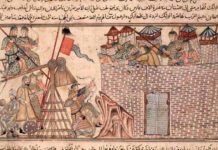
Ramkhamhaeng is considered to be one of the greatest of all Kings of Thai history. He created the city state of Sukothai which achieved a level of culture and achievement grater than any that had been managed by any of the Thais. Through his military valour he conquered a wide swathe of land which, unfortunately, his descendants were unable to maintain.
In the 1240s, the Tai Prince Bang Klang Hao, who headed a small princedom in the region of Sukothai, allied with another Tai prince, Pha Muang and, together, they attacked and overthrew the Khmer Governor of Sukothai. The Khmers (modernday Cambodians), had established a powerful empire in many parts of mainland Southeast Asia which was then waning in power, as so much of the resources had been spent on creating wondrous monuments such as the Angkor Wat complex and on public works such as hospitals. Sukothai is in what is now called central Thailand, a couple of hundred kilometers north of the present location of Bangkok.
Bang Klang Hao took control of Sukothai and he was given the royal title of Sri Indraditya by Pha Muang. On his death, Sukothai passed to Sri Indraditya’s first son Ban Muang who, in 1279, in turn died and so the succession passed to Ramkhamhaeng, who was the second son of Sri Indraditya. It was under Ramkhamhaeng that the city became the vibrant and glorious centre it was later to be.
In the Chiang Mai Chronicle, one of the best sources for this period, Ramkhamhaeng is described as having a supernatural birth:
“There was another king, named King Ruang [Ramkhamhaeng], who was the king of Sukothai. This King Ruang was the son of a fierce ogress named Kangli. The lady beheld a fisherman who was beauteous of form, and took him as her husband; and they had a son, who became King Ruang.” (Chiang Mai Chronicle, p.24)
This form of birth was considered suitable for one of his great stature and renown. He is also said to be skilled at magical arts and capable, for example, of transforming himself into various types of animals and objects. It might be noted that his skill at magic is held to be quite commensurate with his claim to be a devout Buddhist. Nevertheless, he was not apparently free from impropriety. For example, again according to the Chronicle, he seduced the wife of his friend, King Ngam Muang, the ruler of neighbouring Phayao:
There was a lady consort of King Ngam Muang called Lady Ua [of] Chiang Saen who was very beautiful. That lady harboured a grudge against King Ngam Muang for this reason: One day, at a soul-tying ceremony for Ngam Muang, Lady Ua Chiang Saen quarrelled with King Ngam Muang, who told the lady that the beef stew she had made for the ceremony was delicious but a bit too watery. The lady was upset and feared that the king was speaking from bias against her and would no longer seek out her company. King Ngam Muang went off to the city of Chiang Sum. The lady was happy, for she had a desire for King Ruang, who was wont to come past [there] and wash his hair. She waited outside the city. King Ruang knew that Lady Ua Chiang Saen had a hankering for him, so he quietly seduced her many times.” (Chiang Mai Chronicle, pp.24-5)
This is believed to be a historical incident. To obtain redress from Ramkhamhaeng, King Ngam Muang appealed for justice to a third Thai king, Mengrai of Chiang Mai, perhaps the most powerful of the three. Mengrai managed this skillfully so that while Ramkhamhaneg paid a penalty to Ngam Muang, all three kings were then happy to swear an oath of friendship and alliance. This three way alliance was particularly important at that time because, to the north, the Mongols under Kublai Khan had finished conquering China and were in the process of destroying the Kingdom of Nanchao, which previously existed in the modern Chinese province of Yunnan and which had separated China from Southeast Asia.
As king of Sukothai, Ramkhamhaeng created a form of rulership that was greatly different from the very authoritarian and hierarchical approach of the Khmers. In inscriptions famously discovered by King Rama V in the nineteenth century, his regime is described in glowing terms:
“In the time of King Ram Khamhaeng this land of Sukothai is thriving. There is fish in the water and rice in the fields. The lord of the realm does not levy toll on his subjects for travelling the roads; they lead their cattle to trade or ride their horses to sell; whoever wants to trade in elephants, does so; whoever wants to trade in horses, does so; whoever wants to trade in silver or gold, does so. When any commoner or man of rank dies, his estate – his elephants, wives, children, granaries, rice, retainers, and groves of areca and betel – is left in its entirety to his children. When commoners or men of rank differ and disagree, [the King] examines the case to get at the truth and then settles it justly for them.” (in Wyatt, 1994, pp.48-58)
This form of rulership is considered to be uniquely Thai in style and Ramkhamhaeng considered to be the founder of benevolent Thai monarchy, which continues to this day.
References
- Wyatt, David K. and Aroonrut Wichienkeeo, The Chiang Mai Chronicle, second edition (Chiang Mai: Silkworm Books, 1998).
- Wyatt, David K., “Contextual Arguments for the Authenticity of the Ramkhamhaeng Inscription,” in David K. Wyatt, Studies in Thai History (Chiang Mai: Silkworm Books, 1994), pp.48-58.







